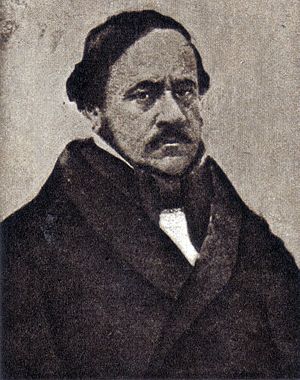José Zapiola facts for kids
José Zapiola Cortés (born in 1802, died in 1885) was a talented Chilean musician, composer, and orchestra conductor. He played a big part in shaping music in Chile during his lifetime.
Contents
José Zapiola's Early Life and Musical Journey
José Zapiola was born in Santiago. His father was Bonifacio Zapiola y Lezica from Argentina, and his mother was Carmen Cortés from Chile. From a young age, José showed a great gift for music. He studied with Fray Antonio Briseño from 1812 to 1815.
He taught himself to play the clarinet in 1819. A Danish businessman and music lover, Carlos Drewetcke, helped him a lot. Later, José trained as a silversmith with Elías Espejo. In 1824, his parents sent him to Buenos Aires to learn more about music, like harmony and composition.
Becoming a Famous Conductor
When José returned to Chile in 1826, he joined the Chiloe campaign as a band-master for the 7th regiment. This meant he led the military band. In 1830, the first opera company came to Chile. Their orchestra leader had passed away. José Zapiola was asked to take his place. He quickly became very famous. Because of his skill, he was often invited to Lima to lead the opera orchestra there.
Zapiola started the first music class at the Normal School in Santiago. He also organized the first public music concerts in Santiago and Valparaíso in 1842. Many people consider him the person who truly started musical art in Chile. The government gave him a gold medal in 1844 to thank him for his services.
José Zapiola and Social Ideas
In 1850, Zapiola joined a group called the Egalitarian Society (Spanish: Sociedad de la Igualdad). This club was started by Rafael Arcos Arlegui and Francisco Bilbao. It was a group that wanted to make society more equal, inspired by the ideals of the French Revolution of 1848. The society was founded in Santiago on April 14, 1850. Most of its members were skilled workers and young people from middle and upper-class families.
In 1853, Zapiola helped start a weekly newspaper called El Semanario Musical. He co-founded it with Isidora Zegers, José Bernardo Alzedo, and Francisco Oliva. This was the first newspaper in Chile focused only on music. He also helped edit another newspaper called Estrella de Chile.
Leading the Conservatory of Music
In 1857, Zapiola became the director of the new Conservatory of Music in Santiago. He taught many artists there. However, he resigned a few months later. He felt the government was not giving enough interest or money to the school. From 1864 to 1874, he became the Choir-master of the Santiago Cathedral. He held this important position until he passed away in Santiago in 1885.
José Zapiola's Musical Works and Writings
José Zapiola created many beautiful musical pieces. Some of his best compositions include:
- Domine ad adjuvandum me (from 1835)
- A Requiem (from 1836)
- Himno al triunfo de Yungay (from 1840)
- Himno a San Martin (from 1842)
He also wrote a book called Remembrances of Thirty Years (Spanish: Recuerdos de treinta años), published in 1872. This book shared historical events, stories about Chilean customs, and memories from his own life.
See also
 In Spanish: José Zapiola Cortés para niños
In Spanish: José Zapiola Cortés para niños


